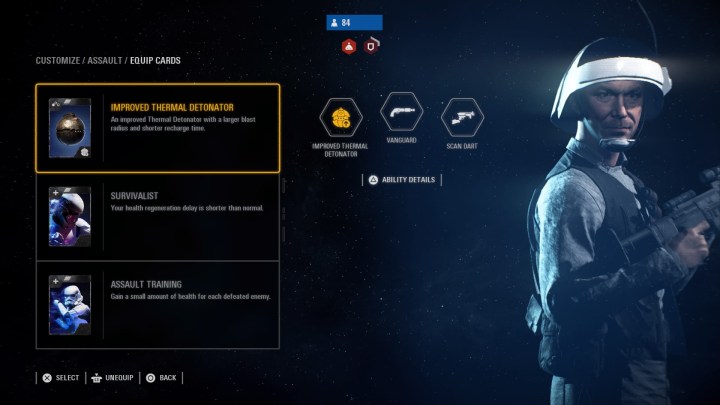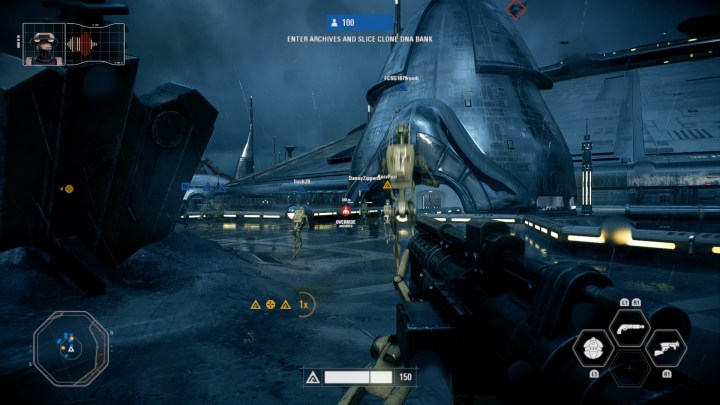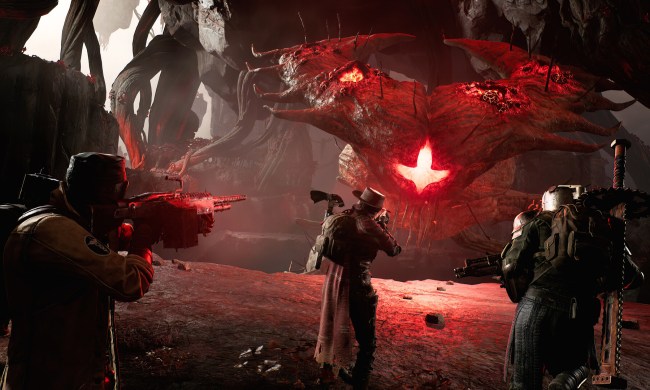Dice and Electronic Arts’ Star Wars: Battlefront II takes players through some of the biggest, most iconic battles in Star Wars history. But like in the previous Battlefront, the only way to defeat the Empire or shut down the plans of the Rebel scum is to work together as a team. There are lots of ins and outs to Battlefront II that aren’t obvious, from the progression system to how the game’s trooper classes interact with each other.
- Stay with your squad
- Keep an eye on your Star Cards
- Stick to the objectives
- Spend time with all the trooper classes and switch frequently
- Use Battle Points for tactical advantages, not just lightsabers
- Take some time to practice flying
- Avoid charging into battle
- Get used to first- and third-person
- Check your milestones
We put together a whole slate of tips that will help you blast through enemy armies, win starfighter dogfights and get the best Star Cards to improve your hero characters and trooper classes. Here is everything you need to know win control of the galaxy in Battlefront II multiplayer.
See more
Stay with your squad

When you spawn during a Battlefront II match, you join the game as part of a squad with other players — either your friends if you’re part of a party, or other teammates. Battlefront II is best played with teammates and as a unit, and it incentivizes you to stick together by increasing the rate you earn “battle points” as you play the game. That means you will be able to access hero characters and starships sooner, plus earn more of Battlefront II‘s in-game currency, credits, when you complete the match.
Beyond the selfish returns you get from hanging out with your squad, you’re more likely to be effective and useful to your team if you’re working together with other players, rather than running off on your own. Teams that work together tend to win in Battlefront II, so do your part for the war effort and stay with your unit.
Keep an eye on your Star Cards

“Star Cards” are the way in which you customize the loadouts that come with every trooper class, hero character, and starship in the game — they are how you make your classes play the way you want them to. But you don’t unlock Star Cards just by playing in Battlefront II; you either need to purchase them with a currency called “crafting parts” or get them out of loot crates (and crates are the only way to get more crafting parts).
As you rack up credits while playing, make sure to drop out of your matches once in a while in order to purchase more crates and get more cards. They offer you chances to change your classes to better fit your play style, as well as to just improve your characters in general, so they are worth a little investment. You can change your Star Cards mid-battle.
Stick to the objectives

In most of the game types in Battlefront II, your purpose isn’t to rack up the most kills, but to conquer a variety of objectives. Even if your team is on defense, you have objectives popping up on screen, telling you what areas to hold, which enemies to prioritize, and where to focus your attention.
Objectives, of course, are the key to victory, so it makes sense that playing them increases your Battle Point score more than running around, racking up kills. If you stay on target, you earn more credits, get to play as heroes quicker, and win more often. So be a good teammate and pay attention to your objectives.
Spend time with all the trooper classes and switch frequently

Battlefront II is designed to be more tactical than its predecessor, with an emphasis on picking different trooper classes, working together as a unit, and working as a team — albeit a huge one. For most of the time when you play multiplayer, you will be using one of four trooper classes, each with different abilities and uses different weapons. It can be tempting to fall into using just one or two classes, particularly if you like sniping or fighting on the front lines, but try to resist that urge.
The different classes in Battlefront II are best used either in response to what the other team is doing or in complementing your squad. Do your best to pick a trooper class that is going to benefit the whole team. For instance, if you are defending a position, you might want to field a heavy trooper for increased firepower. If your team is having trouble crossing a well-defended part of the map, break out a sniper to thin the enemy ranks. And don’t forget about the officer, who can buff other players and can deploy turrets, or with the right card, a squad shield. Change your class as the situation demands and you will win more often than if you’re only good at a single niche role.
Use Battle Points for tactical advantages, not just lightsabers

As you fight in multiplayer, you rack up Battle Points. In between spawns, once you gather enough, you can spend points to deploy as special characters, artillery, or spacecraft. You might think you want to bank all your points for the glory of becoming a Jedi and ripping other players apart, but that is not always what’s best for the team.
Instead, try to use your Battle Points to turn the tide. If a defensive position is particularly tough to crack, a tank or walker might be in order. Starfighters can provide crucial air support for players on the ground, and are essential for taking down AT-AT walkers on maps like Hoth. Read the situation and use your points the best way you can, especially since earning enough to get a hero character can take a very long time.
Take some time to practice flying

Air support is a huge part of Battlefront II that is easily overlooked in Galactic Assault. In most matches, the battle isn’t just taking place on the ground — it’s in the air, too. Letting one team dominate the skies can spell doom for the group for your ground troops, as they get blasted by powerful starfighters. By the same token, you can wreak havoc on the other team if you can gain air superiority.
The trouble is, flying in Battlefront II takes some getting used to. It’s easy to crash or get wiped out by other fighters if you haven’t practiced. It’s worth dedicating some time to messing around with fighters in the campaign or in the Starfighter Assault, the space fighter-only multiplayer mode, so you to hop in an X-Wing or a TIE fighter if your team needs you. Good pilots can make a world of difference in tight matches: Make sure to practice piloting and aiming, but also think about the best ways to support your teammates on the ground. You need starfighters in a lot of matches, especially when you have to take down big AT-AT walkers or MTTs. Plus, flying is a ton of fun once you get good at it, so put in the practice.
Avoid charging into battle

Much of Battlefront II takes place on huge maps, with your starting position placing you pretty far from the action. The size and scope of the game is the appeal, but that means that when you die, you will often find yourself trucking across a huge area just to get back to the action. Still, you want to avoid rushing straight to an objective or tearing across the map in the open, because the size of Battlefront II‘s matches means that there are often other players watching and waiting to take shots at you when your defenses are down.
Instead, try to move up slowly with your team, and get a feel for any given situation. The game often rewards careful players who think about the terrain, and Battlefront II‘s maps are absolutely filled with paths that allow for flanking and surprise attacks. You might feel like you need to get right back into the fight immediately, but that’s a great way to get blasted before you even know what hit you. Take your time and figure out how you can do the most damage to the enemy team — there are plenty of people in any given match who run right to the front line, so you don’t have to.
Get used to first- and third-person

If you’re playing Battlefront II like most multiplayer shooters, you will likely default to first-person mode and play that way for most of the time. It’s the more accurate way to play under most circumstances, allowing you to aim down the sights of your gun and fire most effectively. But there will always be circumstances where you don’t just have the option to play from Battlefront II‘s third-person perspective but are required to do so.
When using Hero characters, “enforcer” classes like Wookiees, and even some of the abilities of the default classes, Battlefront II will force you into the third-person perspective. If you’re not used to it, popping the heavy trooper’s shield only to suddenly find yourself in third-person can be a death sentence. So, as with classes and starfighter piloting, it’s worth the investment to practice playing in third-person mode. It’s a totally different feel from playing in first-person, but some of the strongest multiplayer classes require it, and you’ll want to be ready to be as effective a fighter as possible when you spend those Battle Points.
Check your milestones

Much of the progression in Battlefront II, including earning better Star Cards to improve your characters and classes, is tied to milestones. These are different challenges that reward you with loot crates and currency to buy better cards and unlock new Heroes. There are a huge number of milestones in the game, all available on the “Career” tab of your menu, and unlocking them is key to getting the customization options in Battlefront II that will allow you to build loadouts best suited to your playstyle. In other words, Milestones will help you get better, in a number of ways.
Milestone challenges include everything from spending time in each trooper class, to getting a number of kills with a particular weapon, to achieving wins and objectives in the different Battlefront II multiplayer modes. Before you fire up a game, it’s always worth checking which milestones you’re close to earning and which ones you want to work on. That way, you know if you want to spend more time playing a particular class or working with a specific weapon. Not only do milestones force you out of your comfort zone to try new things, but they help you progress faster. But you can’t check your milestones once you’re in a match, so come prepared knowing what you want to work on to speed up your progression. If you want more detailed advice on which milestones to go after first, you should check out our handy guide for earning credits faster.


